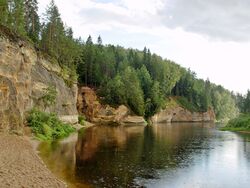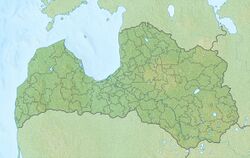Earth:Gauja Formation
| Gauja Formation Stratigraphic range: Givetian ~388–384 Ma | |
|---|---|
 The Ergelu Cliffs along Gauja River, Latvia belong to the Gauja Formation | |
| Type | Geological formation |
| Sub-units | Sietin & Lode Members |
| Underlies | Amata Formation |
| Overlies | Plavinas Formation |
| Thickness | 80 m (260 ft) |
| Lithology | |
| Primary | Sandstone |
| Other | Siltstone |
| Location | |
| Coordinates | [ ⚑ ] : 57°18′N 25°07′E / 57.30°N 25.12°E |
| Paleocoordinates | [ ⚑ ] 10°54′S 10°42′E / 10.9°S 10.7°E |
| Country | |
| Type section | |
| Named for | Gauja River |
The Gauja Formation is a Middle Devonian fossil locality in Estonia and Latvia.[1] It is named after the Gauja River, where it is exposed along the banks.[2]
Description
The Gauja Formation has a maximum thickness of 80 m (260 ft). It is composed of weakly to moderately cemented layers of fine-grained to very fine-grained sandstone. The layer is predominantly light to yellowish-gray in color, but can be pinkish brown or variegated. It is mostly composed of quartzose arenites. It is overlain by the 30 m (98 ft) thick Amata Formation and the Plavinas Formation.[3]
The Gauja Formation contains two cyclic members. The lower layers are known as the Sietin Member and are composed mostly of sandstone with a thin layer of siltstone at the top. [3]
The upper layers are thicker, and the lower part of it is known as the Lode Member. The Lode Member dates from the Middle Devonian and is composed of light colored sandstone. The area is indicative of a near-shore environment of retreating sea.[3]
Paleontology
The Sietin member has yielded numerous fossils of fishes. Among them are Asterolepis, Bothriolepis, Psammolepis, Cheirolepis, [4]Glyptolepis baltica, Laccognathus panderi, Livoniana multidentata,[5] and Megadonichthys kurikae[1]
Only large plant remains and miospores are known from this member. Examples of which include Hostinella, Archaeopteris, Retusotriletes rugulatus, and Ancyrospora. Palynological studies indicate that the Middle to Upper Devonian boundary may exist in this member.[6]
See also
- List of fossiliferous stratigraphic units in Latvia
- List of fossil sites
- Gauja National Park
- Gauja valley
- Gauja River
References
- ↑ 1.0 1.1 "Gauja Stage". Geological collections of Estonia, Institute of Geology at TUT, University of Tartu, Estonian Museum of Natural History. http://geokogud.info/tug/stratigraphy.php?id=185.
- ↑ "Gauja River". Tūrisma informācija īpaši aizsargājamā dabas teritorijā – Gaujas nacionālajā parkā. http://www.gnp.lv/node/434.
- ↑ 3.0 3.1 3.2 Anne Kleesment; Väino Puura; Toivo Kallaste (2002). "Clastic dikes in Middle Devonian sandstones of the Gauja Formation, southeastern Estonia". Proceedings of the Estonian Academy of Sciences, Geology (Estonian Academy Publishers) 52 (3): 155–177. https://books.google.com/books?id=QT_j22wsdzcC&pg=PA155.
- ↑ https://www.researchgate.net/publication/307735390_The_unique_fossil_assemblage_from_the_Lode_Quarry_Upper_Devonian_Latvia
- ↑ Ahlberg et al., 2000
- ↑ Elga Mark-Kurik; Alain Blieck; Stanislas Loboziak; Anne-Marie Candlier (1999). "Miospore Assemblage from the Lode Member (Gauja Formation) in Estonia and the Middle-Upper Devonian Boundary Problem". Proceedings of the Estonian Academy of Sciences, Geology (Estonian Academy Publishers) 48 (2): 86–97. https://books.google.com/books?id=OhH-gqPrkmcC&q=gauja+formation&pg=PA86.
Bibliography
- Ahlberg, P.E.; E. Lukševis, and E. Mark-Kurik. 2000. A near-tetrapod from the Baltic Middle Devonian. Palaeontology 43. 533–548.
 |


